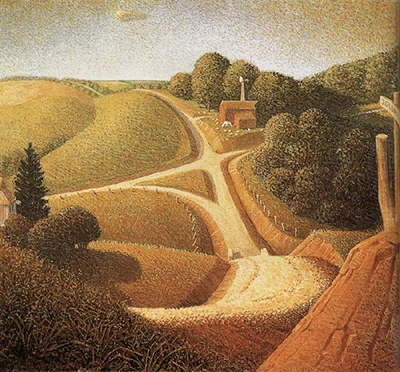New Road is one of the most recognized pieces by Grant Wood, one of the leading America Regionalist artists. The painting is composed using oil on canvas on paperboard media.
However, it is a hardboard frame measuring 21 by 23 by 11/4 inches. The painting was created in the era of the American Realism or Impressionism movement. The landscape artwork was created in 1939.
Description of the painting
New Road features a gravel lane leading to a small city called SOLON. The city's name is represented on a small rustic sign on the top right of this composition. The words "SOLON 5 MI" are inscribed into the rustic sign. The gravel lane features a mid-intersection in a cruciform pattern like the rustic signpost. Each side of the gravel path features a beautiful and dramatic green scene.
The right features beautiful trees featuring varying sizes. There’s also a patch of barren land with no grass or trees between the fertile green land. There are two wooden structures (a large and a small one). The larger appears to be a windmill. Next to the structures, small white images are presumed to be domestic animals. Grant Wood depicted small, obscure images in a lot of his designs. While they appear small, they play a significant role in the overall subject matter of the piece. This element was quite common during this artistic movement and era.
The left side features an undulating green landscape with a few trees on the top left corner. This side also features an obscured image of a building with white frames. Some of the land in the painting is partitioned with small spikes of wood, as is typical in the farmlands. New Road features grass blades, tumbling pebbles, wood grain patterns, and rivulet-ridden mudbanks.
Similar compositions
The renowned painter has composed several paintings detailing idealized rural landscapes in the 1930s. Some of these paintings include Haying and The Birthplace of Herbert Hoover. These paintings are rendered in a detailed and deliberately naïve style. They feature cultivated lands, farms, domestic animals, and some of the primary components of a regular scene in Iowa. Creating such compositions was easy for the painter because of his background.
The riveting nature of New Road can be attributed to the fable-like feel of the subject matter and the light-soft focus of the colours in the painting. The detailed contours also contribute to this element. However, some critics have also pointed out that the painting has a dull demeanour, from the colours to the overall scene. Regardless, most people gravitate towards the unique style and details.




